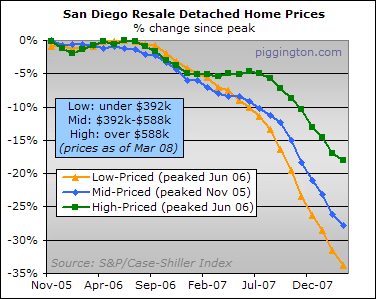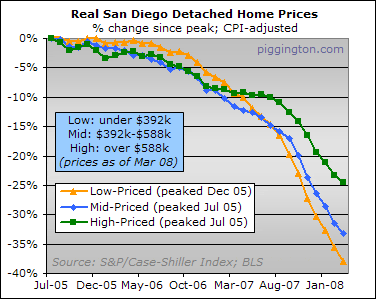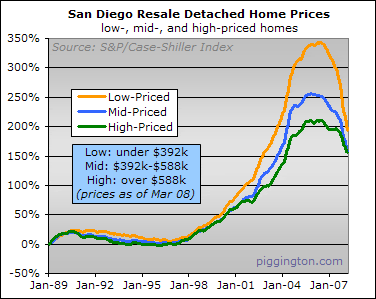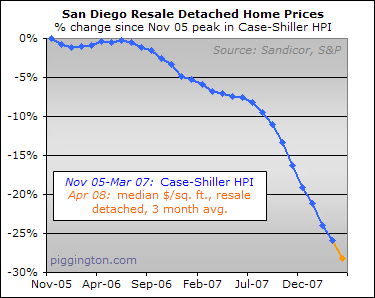San Diego’s home price decline continued in March, according to the Case-Shiller home price index:
For the month, the high tier was down 1.2%, the mid tier 2.3%, and the low tier 3.4%. Compared to earlier in the year, the month-to-month declines slowed somewhat for the high tier, even less for the middle tier, and imperceptibly for the low tier. That’s what passes for a spring rally in this market.
The following graph shows the three tiers’ declines from their respective peaks.

The loss of value is even starker when adjusted for inflation as measured by the CPI:

Here are some longer-term looks, first nominal and then real. As I’ve often discussed, the comparative thrashing being endured by the low end is largely due to the bubble in risky mortgage credit, which had the effect of causing inordinate price rises in the low tier and then resulting in mass foreclosures among those same properties.

Note that in CPI-adjusted terms, valuations are still well above the 1990 bubble peak:

From the November 2005 peak through March, the aggregate HPI had fallen 25.9%. It notably fell to just below the January 2004 value, meaning that we are now at an aggregate price level that hasn’t been seen since 2003.
My simplistic HPI proxy (based on the 3-month average of the change in median price per square foot) did a bang-up job this month, predicting a month-to-month decline of 2.3% versus an actual decline of 2.6%.
Updated for the actual March value, the HPI proxy projects a total decline of 28.2% in April.


Rich,
Thank you very much
Rich,
Thank you very much for the info. One question:
I wonder why you have the X-axis in increments of 5 months? 3, or 6 months seem more natural.
I am a potential home buyer
I am a potential home buyer in North County, waiting to get in at a reasonable price. Instead of timing the bottom which I believe is quite difficult (else we would all be millionaires :-)), I thought lets go the other way and try to price the bottom. Here's my simple model for it. Lets start with a base of year 2000 home prices, as I believe the irrarational exuberance commenced around then. For this I looked up a random 2000 sq.ft. 4b/3b home in San Marcos from zillow.com that was about $220,000 in 2000. Assuming a strong local economy home value appreciation should be about 5%-7% annually. So taking an average of 6% compounded growth rate, above home should be valued around $395,000 in 2008. That tells me that if I can get that price, or even lower for a foreclosure, by this year end it might be all right to buy. Same model can be extended for any size home in area you are interested in. I am interested in what other piggington readers think about my reasoning. BTW Rich you the man for coming up with this site. For disclosure, I have no finance or real estate background. I am a faculty in a business school in North County and I like examining such interesting conundrums.
Thanks
Thanks sdncresbuy…
jimmyle, I fit in as many months as I can on the lower axis without wrapping.
Rich
A couple thoughts for
A couple thoughts for “sdncresbuy”.
The home you described could be found in primarily Santa Fe Hills or Discovery Hills back in 2000. That home was selling between $270,000 and $300,000 in 2000 and likely had none of the “bells and whistles” today’s buyers look for. Today I could find you that home between $375,000 and $400,000. With a little luck you might even get the “bells and whistles”. More likley, you will go after something of the more recent vintage which will be bigger and more upgraded. For that you will pay more. In San Marcos, the scenario you are waiting for has already arrived.
If you want to live closer to the coast, you’ll have to wait longer for it.
sdncresbuy-
With the
sdncresbuy-
With the exception of making any decisions based on zillow valuations, that seems like a pretty good basic strategy. I’m keeping my eyes on similar price benchmarks combined with foreclosure/sales figures. On a side note, I noticed this time looking at the inflation adjusted prices that at the end of 2001, right after surpassing the previous boom inflation adjusted figures, SD’s median started to flatten and recede briefly. Just thought this was an interesting blip because you don’t notice the similar peak heights without it being inflation adjusted. This is pretty much the point you could say irrational exuberance took control.
To sdncresbuy,
This is
To sdncresbuy,
This is exactly the method I am using. However, base on my calculation [220,000*(1.06^8)]=220,000*1.594=350K. So I’m not sure how did you come up with 395K?
Another way of looking at
Another way of looking at the same thing is to notice in Rich’s charts that prices for low-tier houses (which $220K would be) rose from 50% (of 1989 base price) in 2000 to 80% sometime in 2001, which is a 60% increase. Since compounding 8 years at 6% (1.06^8) is approximately a 60% increase, what it means is that current prices should really be at 2001 prices.
So, if you see a listing price close to 2001 price, then that’s probably a good deal in the long term, riding out any over-correction in the short-term.
There might be a few REO’s out there at 2001 price levels, but most properties I’ve looked at seem to be priced at 2003-4 levels. So still some ways to go…
why do you assume an annual
why do you assume an annual appreciation rate of 6%? is that the average salary appreciation rate of people in SD? is that the average inflation rate?
According to Shiller’s study of the last 200 years, the Real housing price should be flat (after inflation).
Why prople always assume that housing price must appreciate?
6%/year is too much. The
6%/year is too much. The long term real rate of appreciation for housing in the United States is .2% (see Business Week), or statistically zero. So use the CPI instead. Better yet, use price/rent ratios. If price/rent is low based on long-term averages, buy and don’t worry about the bottom because real prices will go back up, barring long-term regional economic decline.
A house is a durable consumer good that generates shelter, that’s its’ return. Its’ value is just as likely to go down in real terms as it is to go up; ask any Detroiter.
If housing appreciated in real terms over the long run, that would mean that rents would also have to increase in real terms over the long run. That will only happen if the real cost of producing housing rises. Technological progress tends to run in the opposite direction, decreasing costs rather than increasing them.
hey, but the REAL inflation
hey, but the REAL inflation numbers are more like 11% =)
I too think 6% is high,
I too think 6% is high, though I agree real inflation (of everything else) is over 10%.
Home prices track incomes. If incomes grew at 6% across the board, and the number of jobs kept up with population growth then okay, but that’s not happening.
Are you assuming that
Are you assuming that inventory and population growth have returned to their respective means once you get your price target? Think of all those condo conversions and new developments. And last time I looked, CA actually had a net decrease in population year over year (Thanks Texas). So once your price target is hit, prices may continue to slide if there is still an oversupply of units and/or population growth rate is below its historic average.
Wonderful responses for
Wonderful responses for pricing bottom model piggs. This site is great. Using other methods for pricing, such as renting to mortgage ratio or a different annual appreciation rate, can I have your estimates of what a 2000 sq.ft. 4b home should be priced in 2008 at say San Marcos if reasonable historical housing trends had been followed (and not crazed buying frenzy of last few years). Perhaps Rich can also take a crack at this if he would be so kind. BTW I acknowledge an error that was pointed out. I actually start with a base price of $250,000 in 2000 for above home, that leads to slightly under $400,000 in 2008 at 6% annual growth rate. I was going to post this correction earlier, but wanted to wait for some comments before doing so.
I agree with ocrenter here.
I agree with ocrenter here. I think that it would be worth while to see your results charted against more realistic inflation numbers, such as the 11%+ figure posted here: http://www.signonsandiego.com/news/business/20080417-9999-1n17inflate.html#inflate
[img_assist|nid=7734|title=|desc=|link=node|align=left|width=466|height=378]
Hola greekfire — I agree
Hola greekfire — I agree that the CPI understates inflation but the Shadow Stats number don’t make sense to me.
The main difference between the pre-1983 and post-1983 (aka pre-1998) method is, as I understand it, that they substituted owner’s equiv. rent for home prices in 1983. If that’s the case, then the pre-1983 number should have been way higher than the post 1983 number during the housing boom, and it should be LOWER now that home prices are declining.
Instead, the spread between pre-and post-1983 did not change pre- and post-boom… which makes me suspect that he has just calculated an average spread between the two and applies the same spread every month.
I am very sympathetic to the goal of creating better inflation metrics but these numbers just don’t make sense to me. If anyone can tell me why I’m wrong I am all ears.
Until then, this is why I’ve focused on the price to income ratio and price to rent ratio — not only are they closer to the true fundamentals for housing, but they are less “over-adjusted” than the CPI.
Rich
Ciao Rich. I also had some
Ciao Rich. I also had some questions with the graph that I previously posted. My main point was to express how the current inflation value, or CPI, was a poor metric for true inflation, and how it would be interesting to see some of your charts based on more realistic inflation data. I didn’t do a good job of expressing it in this way, and I know it is quite difficult to get a solid grasp on how inflation is truly calculated. I read in one place that it is better to use M2 and M3 money supply rather than CPI. However, I understand that true M3 data is not easy to come by.
Anyways, what I was trying to get across was that it would be interesting to see a higher inflation rate used in some of your charts, say between 5-10%, or whatever…sort of as a worst-case (or more realistic) outlook on economic indicators.
For example, you would have your standard charts that are based on the standard data that you have been tracking for a while. You could possibly create a new chart that would express various data in relation to a higher (some say more realistic) form of inflation figures that you’ve obtained from Organization XYZ, or even a more custom metric based on your own research.
robson said:
On a side note,
robson said:
On a side note, I noticed this time looking at the inflation adjusted prices that at the end of 2001, right after surpassing the previous boom inflation adjusted figures, SD’s median started to flatten and recede briefly.
————————–
I noticed this too, and thought that things were already getting over-heated by 2001 (our house had already doubled by then from 1998 purchase)…and that 2001 was the peak of the natural RE cycle **and would have gone down from there if not for the credit bubble.**
There are two conditions which allow people to spend more on housing: increased incomes/wealth and increased access to credit. Starting in 2001, we saw the credit markets unleashed on the housing market. That is starting to contract. Are incomes high enough (and going higher) to push prices up? Are well-paying and stable jobs more available or less available than in 2001? What does the future look like for wages in the U.S.? How about pension/retirement savings? Does our collective financial situation — outiside of housing — look like it will get better or worse in the short and long-term future? What do the future demographic changes say about the future of home prices (think Baby Boomers who had greater access to defined-benefit pension plans, employer-paid healthcare and more stable jobs…their population will be shrinking in the future)?
People often think that high inflation should push housing prices up. That only works if WAGES are going up. If wages are stagnant or down, and the price of everything else is going up, there is **less** money left to allocate toward housing costs. This is deflationary for housing.
IMHO, there is a very strong possibility that we will see pre-2001 prices. Demographic and credit market conditions over the past 60+ years have made housing and stocks a no-brainer. That does not mean that these conditions will continue indefinitely.
If the credit markets were to return to pre-1982 levels, where would housing prices be? (definitely extreme, but one should always consider the worst-case scenario, IMO) At some point, lenders will want all their money back (with interest!) Do we have enough money in this country to pay back our loans (public and private)?